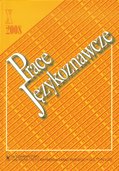Relacja przeciwieństwa znaczeniowego między
dwiema jednostkami leksykalnymi z perspektywy przeciętnego użytkownika języka.
Badanie psycholingwistyczne
The relation of the semantic opposition between two lexical units from the perspective of the average language user.
The psycholinguistic research
Author(s): Nawoja Mikołajczak-MatyjaSubject(s): Theoretical Linguistics, Applied Linguistics
Published by: Wydawnictwo Uniwersytetu Warmińsko-Mazurskiego w Olsztynie
Keywords: linguistics; semantics; lexicology; psycholinguistics
Summary/Abstract: The article deals with the issue of the semantic opposition as an interdisciplinaryproblem and aims to check the psychological reality of the linguistic approach to the relation.It has been shown that the recognition of the essence of the semantic opposition asa combination of similarities and differences is the starting point of the linguistic analysesof the relation, the basis for the issue of how to organize its examples in contemporarycorpus research and the reason for treating it as similar to the synonymy relation. Someresults of psycholinguistic research showing how language users understand the semanticopposition were mentioned. Then, the author’s own study was presented: a test of guided(directed) associations, in which the stimuli were words without the obvious, well-establishedsemantic opposition in Polish. 720 Polish native speakers were instructed to provide“maximally semantically opposed” words to the list of 12 stimuli words, Polish nouns fromsemantic fields of living organisms and artifacts. Each stimulus word came from a multi-element set of co-hyponyms and at the same time a set of co-meronyms. It was assumedthat the reactions qualified as co-hyponyms and/or co-meronyms of the stimulus can betreated as evidence of the understanding of semantic opposition as a relation based on semanticsimilarity. The respondents showed a strong tendency to provide reactions that areco-meronyms and at the same time co-hyponyms of stimuli (for 11 stimuli, such reactionsaccounted for 40% to almost 90% of all responses) or co-hyponyms (but not co-meronyms)of stimuli. In addition, a group of answers indicating the treatment of the relationshipbetween the part and its whole as an semantic opposition was extracted. However, therewere also reactions indicating the understanding of the semantic opposition in termsof very strong differences: the names of objects from distant areas of the universe in relationto the denotatum of the stimulus or words suggesting the non-existence of the denotatumof the stimulus. It was concluded that the naive understanding of the semantic oppositionis close to linguistic approaches, but is not identical with them.
Journal: Prace Językoznawcze
- Issue Year: 20/2019
- Issue No: 1
- Page Range: 121-144
- Page Count: 24
- Language: Polish

